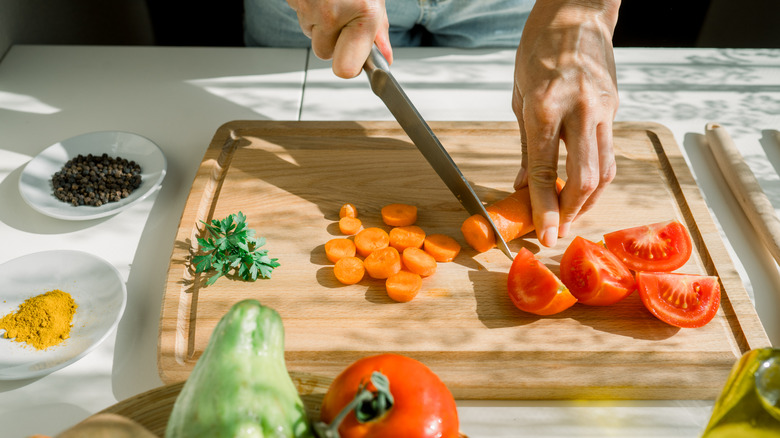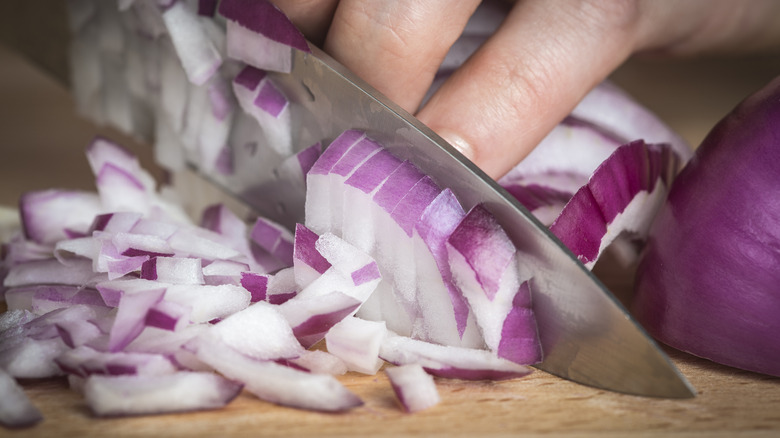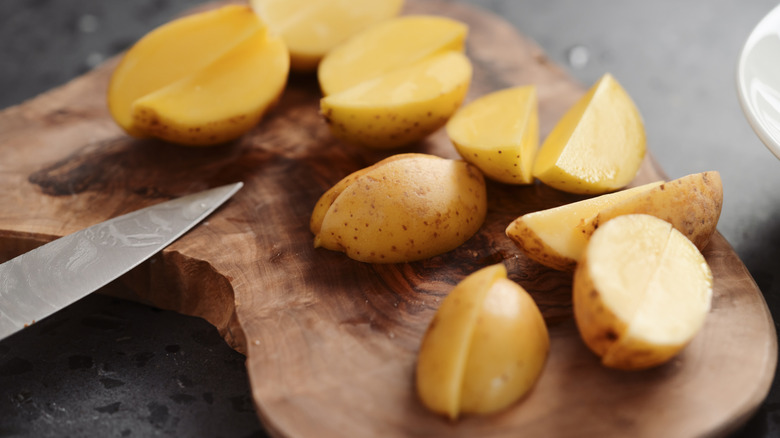Is There Really A Difference Between Dicing And Chopping? Here's What To Know
Most home cooks don't follow recipes to a T – there might be a lot of improvising involved, like subbing in Worcestershire sauce for soy sauce, or replacing sour cream with Greek yogurt in some applications if that's all you have on hand. One thing that might trip you up in recipes is when you're assembling your mise en place and notice a dice or a chop is called for. What's the difference? Surely you can just cut up the carrots or onion and call it a day? Not so, according to Joanne Gallagher, recipe creator and co-founder of Inspired Taste.
She told Food Republic, "I take chopping as cutting food into larger, rough, and irregular pieces, like in rustic, hearty stews, where every chunk is just a bit different." In contrast, she felt that dicing is for creating smaller, neater, and more consistently sized cubes, which she feels should be about one-fourth to a half inch big. The uniform shape helps everything distribute evenly in dishes like salsas and salads, but the dice is also useful when cooking proteins, like chicken, to ensure that everything sears consistently. Gallagher had more advice to share for how to achieve a good dice and chop, as well as when to use both.
Dicing: Smaller cubes take time
Joanne Gallagher recommended practicing your dicing skills when cutting up vegetables for soups, sautès, and sauces, as well as fried rice (who doesn't want to imitate those cute little carrot cubes that come in the takeout versions?), "because they'll cook through at the same time and have the same or similar texture." After all, no one wants to bite down on a piece of half-raw carrot chunk, she reminded us.
When it comes to the actual practice of dicing, Gallagher suggested carefully trying to cut the vegetables into uniform shapes. "Many home cooks try to dice quickly and end up with uneven bits," she said, "some too small and others too large." Again, this can have dire effects on both whether or not the veggies all cook at the same rate, and then the final product, where bigger pieces are less done than smaller ones. Gallagher admonished home cooks to take it slow; try slicing your carrots or zucchini into evenly sized, flat planks before deciding how big to make vertical cuts. Then turn them into cubes by cutting horizontally. "It's a little more work, but it's worth it!" she insisted.
Chopping: Coarser pieces make using a knife fun
Chopping is a different beast, though, according to our expert Joanne Gallagher, more suited toward vegetables going into casseroles and braises, "because they withstand longer cooking times, delivering satisfying, distinct bites." Recipes might distinguish between a rough chop or a fine chop; the difference will be the size of the pieces, with rough chops yielding bigger pieces, and fine chops smaller chunks (that still don't have the uniformity of diced pieces).
As for how to achieve a good chop, Gallagher emphasized that in this case, speed can be your friend (provided you are skilled enough with a knife; otherwise, take it more slowly), and you can have a little fun creating these bite-sized pieces. While you do still want the chunks to be roughly the same size, "a little variation in size gives your dish charm and a rustic, homemade feel," Gallagher said. If you're chopping potatoes, for example, to sit under a roasting chicken, start by cutting them in half so you have a flat side on which to rest them (for stability). Then cut each half down the middle vertically, and finally, make evenly spaced horizontal slices. Overall, Gallagher told us, "Choosing the right cut...will bring out the best in the flavor and look of your finished dish."



